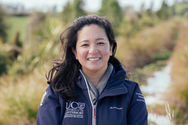
Scientists working with Living Water: Dr Catherine Febria
The Living Water partnership brings in farmers, scientists, councils, communities and mana whenua, and getting work done that could never be done alone.
And no one knows this better than Dr Catherine Febria of CAREX. She is part of a team of scientists at the University of Canterbury that are trying out solutions to improve waterways. Living Water has supporting CAREX’s work in Silverstream, a tributary of the Selwyn River. We caught up with her on what makes her tick: doing science in the real world.
Describe a typical day
I have two major roles – I’m both a director and a scientist.
So a typical day involves research management, but also looking at projects with curious eye to see what’s working and what’s not, and what could be useful to others around the country.
A lot of my job is about being the hub – facilitating connections between people. In the mornings I’ll catch up with members of our team or programme partners. This could be students needing help with experiments or presentations, or with our team scientists on aspects of ongoing projects, or our science communicator Kristy, or connecting with policy-makers and partners outside of CAREX.
By training I’m an ecologist and environmental scientist, so I love freshwater ecology, but never ecology in isolation. I’ve always been about solving problems, finding an end use application for research, thinking about the big picture.
Big picture thinking and making meaningful connections between science and the real world does take time and practice – you have to be open and transparent. Our ethos is, we might not have all the answers yet, but we can still embrace what we do know and move forward. If an experiment doesn’t work, well that’s a learning moment, and if it does work, how can we scale it?
Why do you do your job?
I’m passionate about healing damaged/stressed freshwater ecosystems.
I’ve worked in the Great Lakes of Canada, the Arctic, and the US Chesapeake Bay ecosystems. But I always wanted to do more trialling of solutions for environmental issues – I’m really interested in applying insights from ecology, which is the study of interactions among organisms and the environment, to help meet the needs of the planet.
So when the opportunity to work in Aotearoa New Zealand came up, where freshwater is a critical issue with solutions needed and a lot of policy currently being drafted around it I jumped at it. I knew I would get to do great work with the University of Canterbury, with its world-class freshwater expertise. Plus, the fact we could grow partnerships with industry and government through CAREX meant we could really align science with practice and policy.
Trialling solutions is how we need to move forward around the world. In US I worked a lot with modellers, because there was limited opportunity to trial things at scale. Also the scale of problem is so much larger in US and around the world (Europe), and there’s different legislation which means farmers did not have the same incentives for working with directly with on-the-ground freshwater scientists to trial solutions
In the five years before CAREX, the Mackenzie Trust-funded project did really robust science to understand the patterns of multiple stressors affecting agricultural waterways, but since CAREX kicked off in 2013, it has been truly about talking to farmers and trialling solutions, which was perfect for me.
What difference is it making?
We couldn’t have done anything in Silverstream (a stream amidst dairy farms in Canterbury) without Living Water – for example using grants and in-kind resources to create a demonstration site on-farm, connecting us with the community, profile raising.
A lot of the time farmers and scientists are unable to work with each other or need time to build trust, but this partnership is a way of showing what successful alignment and collaboration could look like. You can talk about it, but it’s the active doing, and showing what co-design looks like that makes the difference.
Partnering in this way also means that as university scientists we can work in the real world – and with farmers being involved it means the project doesn’t finish when money runs out, because there is this community stewardship in place. This gives us a better chance of answering questions and quantifying lessons learned our work in the long-term which is rare/challenging for freshwater restoration.

Dr. Catherine Febria
I’m an ecologist and environmental scientist, so I love freshwater ecology but never in isolation. I’ve always been about solving problems, finding an end use application for research, thinking about the big picture.